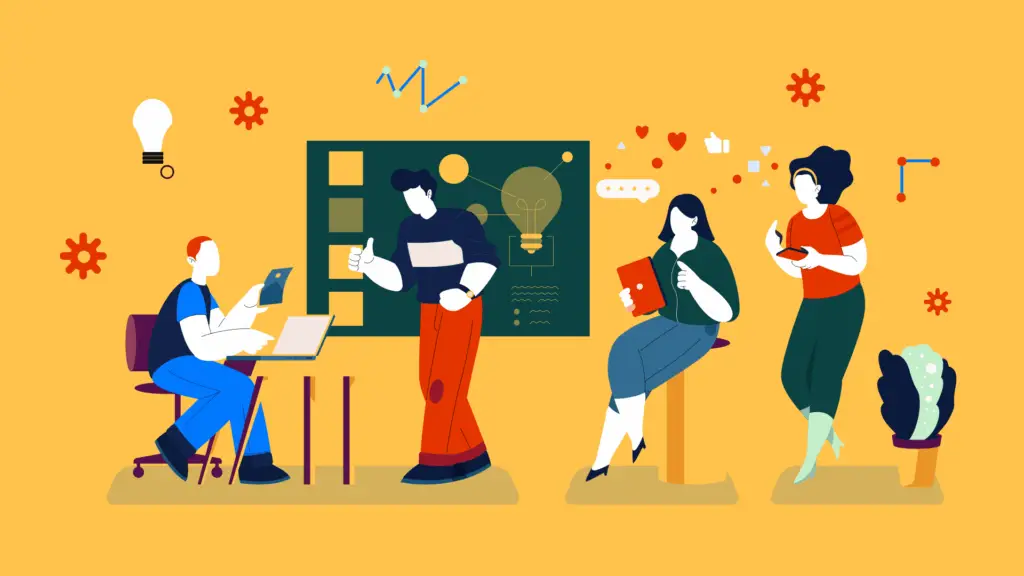To help you optimize your company’s design operations, follow this six-step graphic design process:
- Comprehensive Content Brief
- Team Organization
- Taks Breakdown
- Iterate on Variations
- Use the 10/50/99 Feedback Rule
- Anticipate Key Concerns
1. Be Comprehensive With Your Creative Brief
Every successful design project starts with a well-structured creative brief—a document that outlines the project’s objectives, scope, and required elements. Without it, designers risk working on misaligned concepts, which leads to wasted time and multiple revisions.
A well-prepared brief minimizes confusion and ensures your designers have a clear reference point throughout the project.
A well-crafted creative brief should include:
- Company profile: A snapshot of your brand’s identity and purpose.
- Project specifications: Deliverables, dimensions, and format requirements.
- Brand guidelines: Logo usage, colors, fonts, and visual styles.
- Target demographic: Who the design should appeal to.
- Budget & deadlines: Resource allocation and project timelines.
- Inspiration & references: Examples of design styles the client or stakeholders prefer.
If you’re struggling to define your brand identity, check out these 5 branding tips from memorable brands for inspiration. Once you have your brief in place, review it with key decision-makers to ensure alignment before starting the design work.
2. Know How to Organize Your Team
Your design team structure plays a critical role in workflow efficiency. Here are the three most common setups, each with its advantages and challenges:
- Centralized Design Team: A single in-house design team handles all requests from various departments. While this ensures consistency, it can lead to bottlenecks when demand spikes.
- Cross-functional Design Team: Designers are embedded in different departments. This setup allows for more specialized attention but requires highly versatile designers who can adapt to varied design needs.
- Flexible Design Team: This model relies on external resources, such as freelancers, agencies, or design subscription services. It offers scalability, cost-efficiency, and access to a broad range of design expertise without the burden of managing an internal team.
If you’re struggling with fluctuating design workloads, a hybrid approach—combining in-house designers with on-demand design services—can give you the best of both worlds.
3. Break Down Tasks with Timelines and Requirements
Even the most skilled designers need clear, structured workflows. Without them, project execution becomes chaotic, leading to missed deadlines and unnecessary stress.
To keep projects on track:
- Break down large projects into smaller, manageable tasks.
- Assign specific roles and responsibilities to avoid overlaps.
- Use project management tools like Asana, Trello, or ClickUp to track progress.
- Set realistic deadlines with built-in buffer periods for revisions.
A structured approach prevents last-minute scrambles and ensures smooth execution from start to finish.
4. Develop Variations for Your Design
Not every design will get immediate approval. Instead of presenting just one option, prepare multiple variations. This helps:
- Facilitate discussions and understand stakeholder preferences.
- Reduce revision cycles by proactively addressing potential concerns.
- Provide fallback options in case one design doesn’t work.
When presenting variations, highlight what makes each unique and how they align with the project goals. This approach fosters collaboration and speeds up decision-making.
5. Implement The 10/50/99 Feedback
Gathering feedback at the right time prevents costly late-stage revisions. A structured feedback loop ensures alignment throughout the process. Use the 10/50/99 method:
- 10% Completion: Validate the initial direction, including mood boards and wireframes.
- 50% Completion: Check mid-stage progress to ensure the design aligns with the original vision.
- 99% Completion: Finalize minor tweaks before the design goes live.
By integrating feedback at key milestones, you minimize rework, shorten approval times, and maintain creative momentum.
6. Anticipate Key Concerns
The final presentation isn’t just about showcasing the design—it’s about addressing potential concerns proactively. Before submitting your work, ask yourself:
- Does the design align with brand guidelines?
- Is it optimized for different platforms (print, web, mobile)?
- Have accessibility and readability been considered?
- Are there backup options if the stakeholders request changes?
If logo design is part of the project, make sure you’re following best practices. Here’s what makes a good logo to ensure your design meets high standards.
By anticipating feedback and preparing rationales for design choices, you position yourself as a strategic partner rather than just an executor.
Streamline Your Graphic Design Process with Design Force
Optimizing your graphic design process is all about preparation, organization, and smart resource management. Whether you’re refining your in-house workflow or exploring external support, a scalable solution can make all the difference.
That’s where Design Force comes in. We provide on-demand design services that seamlessly integrate with your team, helping you tackle design bottlenecks, meet deadlines, and scale effortlessly. Our subscription-based model gives you access to world-class designers without the hassle of hiring, training, or managing freelancers.
Let us show you how it works. Get in touch, and let’s elevate your design production process together.



